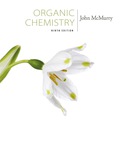
EBK ORGANIC CHEMISTRY
9th Edition
ISBN: 8220100591310
Author: McMurry
Publisher: CENGAGE L
expand_more
expand_more
format_list_bulleted
Question
Chapter 19.SE, Problem 85AP
Interpretation Introduction
Interpretation:
Given that glucose when treated with NaBH4 gets reduced to yield sorbitol. How this reduction process occurs is to be shown.
Concept introduction:
The cyclic pyranose ring in glucose, when cleaved, will yield the open chain compound with a free
To show:
How the reduction of glucose by NaBH4 to yield sorbitol occurs.
Expert Solution & Answer
Trending nowThis is a popular solution!
Learn your wayIncludes step-by-step video

schedule05:53
Students have asked these similar questions
7
Draw the starting alkyl bromide that would produce this alkyne
under these conditions.
F
Drawing
1. NaNH2, A
2. H3O+
£
4 Temps to rise
Tomorrow
Q Search
H2
7
Comment on the general features of the predicted (extremely simplified) ¹H-
NMR spectrum of lycopene that is provided below.
00
6
57
PPM
3
2
1
0
Indicate the compound formula: dimethyl iodide (propyl) sulfonium.
Chapter 19 Solutions
EBK ORGANIC CHEMISTRY
Ch. 19.1 - Prob. 1PCh. 19.1 - Draw structures corresponding to the following...Ch. 19.2 - Prob. 3PCh. 19.2 - How would you carry out the following reactions?...Ch. 19.4 - Treatment of an aldehyde or ketone with cyanide...Ch. 19.4 - p-Nitrobenzaldehyde is more reactive toward...Ch. 19.5 - Prob. 7PCh. 19.5 - The oxygen in water is primarily (99.8) 16O, but...Ch. 19.6 - Prob. 9PCh. 19.8 - Show the products you would obtain by...
Ch. 19.8 - Prob. 11PCh. 19.8 - Prob. 12PCh. 19.9 - Prob. 13PCh. 19.10 - Prob. 14PCh. 19.10 - Prob. 15PCh. 19.11 - What carbonyl compound and what phosphorus ylide...Ch. 19.11 - -Carotene, a yellow food-coloring agent and...Ch. 19.12 - Prob. 18PCh. 19.12 - Prob. 19PCh. 19.13 - Prob. 20PCh. 19.13 - Treatment of 2-cyclohexenone with HCN/KCN yields a...Ch. 19.13 - How might conjugate addition reactions of lithium...Ch. 19.14 - How might you use IR spectroscopy to determine...Ch. 19.14 - Prob. 24PCh. 19.14 - Prob. 25PCh. 19.14 - Prob. 26PCh. 19.SE - Each of the following substances can be prepared...Ch. 19.SE - Prob. 28VCCh. 19.SE - Prob. 29VCCh. 19.SE - Prob. 30MPCh. 19.SE - Prob. 31MPCh. 19.SE - Prob. 32MPCh. 19.SE - Prob. 33MPCh. 19.SE - Prob. 34MPCh. 19.SE - Prob. 35MPCh. 19.SE - It is not uncommon for organic chemists to prepare...Ch. 19.SE - Prob. 37MPCh. 19.SE - Prob. 38MPCh. 19.SE - Prob. 39MPCh. 19.SE - Prob. 40MPCh. 19.SE - Aldehydes and ketones react with thiols to yield...Ch. 19.SE - Prob. 42MPCh. 19.SE - When cyclohexanone is heated in the presence of a...Ch. 19.SE - Prob. 44MPCh. 19.SE - The Meerwein-Ponndorf-Verley reaction involves...Ch. 19.SE - Propose a mechanism to account for the formation...Ch. 19.SE - Prob. 47MPCh. 19.SE - Prob. 48MPCh. 19.SE - Treatment of an , -unsaturated ketone with basic...Ch. 19.SE - Prob. 50MPCh. 19.SE - Prob. 51MPCh. 19.SE - Prob. 52MPCh. 19.SE - Prob. 53MPCh. 19.SE - Prob. 54APCh. 19.SE - Draw and name the seven aldehydes and ketones with...Ch. 19.SE - Give IUPAC names for the following compounds:Ch. 19.SE - Draw structures of compounds that fit the...Ch. 19.SE - Predict the products of the reaction of (1)...Ch. 19.SE - Show how you might use a Wittig reaction to...Ch. 19.SE - How would you use a Grignard reaction on an...Ch. 19.SE - Prob. 61APCh. 19.SE - Prob. 62APCh. 19.SE - How would you synthesize the following substances...Ch. 19.SE - Carvone is the major constituent of spearmint oil....Ch. 19.SE - How would you synthesize the following compounds...Ch. 19.SE - At what position would you expect to observe IR...Ch. 19.SE - Acidcatalyzed dehydration of...Ch. 19.SE - Choose the structure that best fits the IR...Ch. 19.SE - Propose structures for molecules that meet the...Ch. 19.SE - Prob. 70APCh. 19.SE - Prob. 71APCh. 19.SE - When 4hydroxybutanal is treated with methanol in...Ch. 19.SE - Prob. 73APCh. 19.SE - Prob. 74APCh. 19.SE - Prob. 75APCh. 19.SE - Prob. 76APCh. 19.SE - Prob. 77APCh. 19.SE - Tamoxifen is a drug used in the treatment of...Ch. 19.SE - Compound A, MW 86, shows an IR absorption at 1730...Ch. 19.SE - Compound B is isomeric with A (Problem 19-79) and...Ch. 19.SE - The 1HNMR spectrum shown is that of a compound...Ch. 19.SE - Prob. 82APCh. 19.SE - Propose structures for ketones or aldehydes that...Ch. 19.SE - Prob. 84APCh. 19.SE - Prob. 85APCh. 19.SE - The proton and carbon NMR spectra for each of...Ch. 19.SE - The proton NMR spectrum for a compound with...
Knowledge Booster
Similar questions
arrow_back_ios
SEE MORE QUESTIONS
arrow_forward_ios
Recommended textbooks for you
 Introduction to General, Organic and BiochemistryChemistryISBN:9781285869759Author:Frederick A. Bettelheim, William H. Brown, Mary K. Campbell, Shawn O. Farrell, Omar TorresPublisher:Cengage Learning
Introduction to General, Organic and BiochemistryChemistryISBN:9781285869759Author:Frederick A. Bettelheim, William H. Brown, Mary K. Campbell, Shawn O. Farrell, Omar TorresPublisher:Cengage Learning Organic ChemistryChemistryISBN:9781305580350Author:William H. Brown, Brent L. Iverson, Eric Anslyn, Christopher S. FootePublisher:Cengage Learning
Organic ChemistryChemistryISBN:9781305580350Author:William H. Brown, Brent L. Iverson, Eric Anslyn, Christopher S. FootePublisher:Cengage Learning

Introduction to General, Organic and Biochemistry
Chemistry
ISBN:9781285869759
Author:Frederick A. Bettelheim, William H. Brown, Mary K. Campbell, Shawn O. Farrell, Omar Torres
Publisher:Cengage Learning

Organic Chemistry
Chemistry
ISBN:9781305580350
Author:William H. Brown, Brent L. Iverson, Eric Anslyn, Christopher S. Foote
Publisher:Cengage Learning
